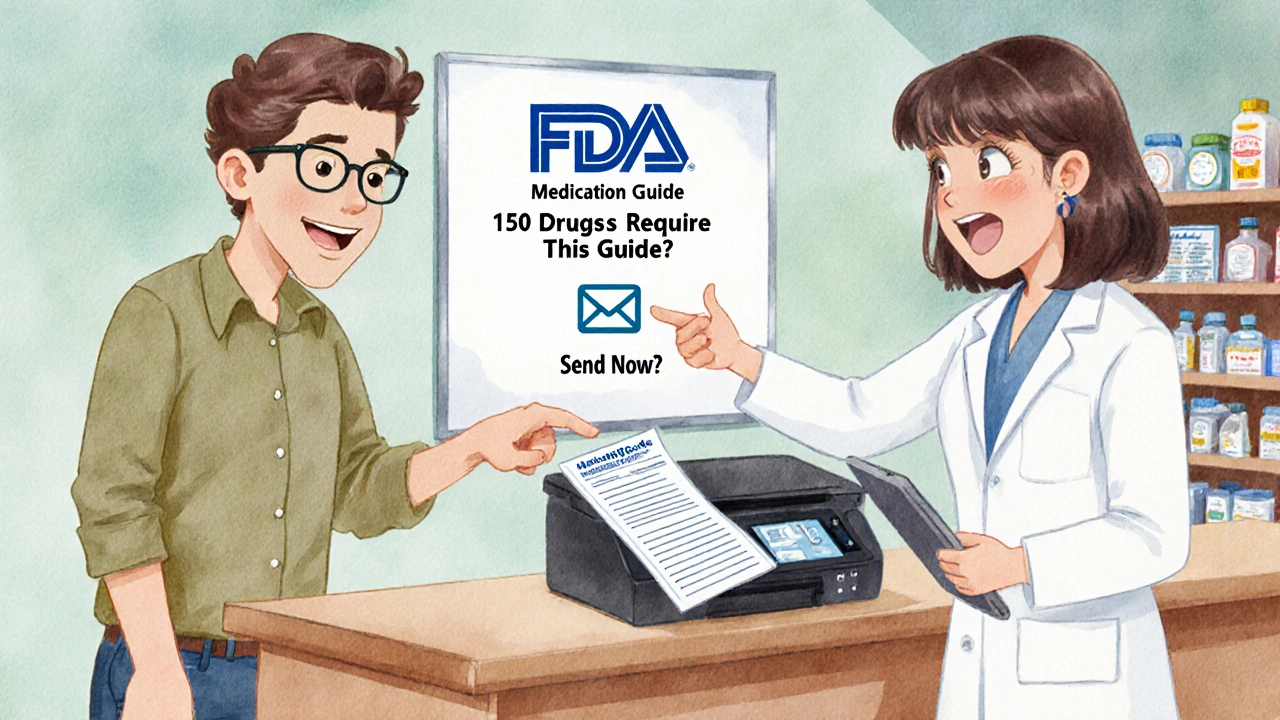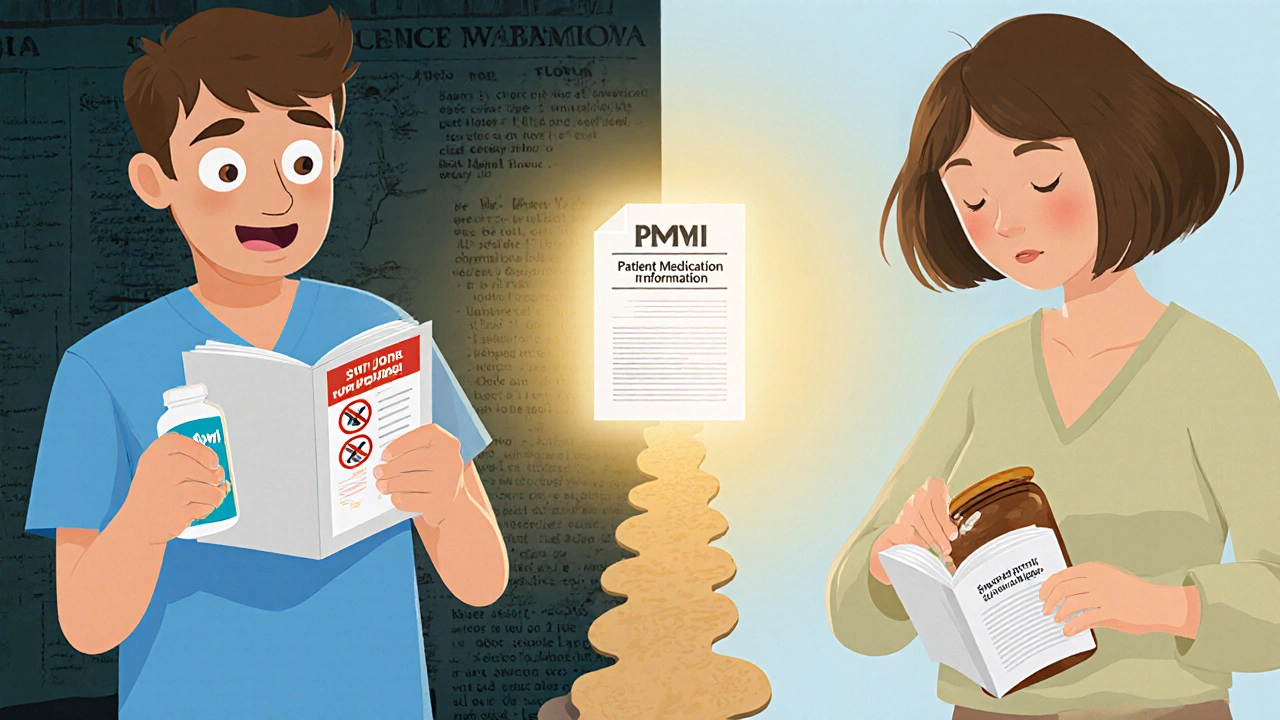Medication Guide Request Assistant
Know Your Rights
The FDA requires pharmacies to provide a Medication Guide for about 150 prescription drugs with serious safety risks.
Important: You have the legal right to receive a Medication Guide at the time of pickup. It's not optional.
Step 1: Check if Your Prescription Requires a Guide
Approximately 5% of all prescription drugs require a Medication Guide. These are medications with serious risks that could cause hospitalization, death, or other severe consequences.
Sample Script for Requesting a Guide
"I understand that my prescription requires an FDA Medication Guide. Can you please give me the printed copy? If you don't have it on hand, can you print one for me right now? I'd also appreciate if you could explain the most important safety information."
Pro tip: Always ask for the printed guide at the time of pickup, not later. The law requires it to be provided then.
When you pick up a prescription, you might not think twice about the small paper insert that comes with it. But for some medications, that paper isn’t just a reminder-it’s a legal safety document. The Medication Guide is a federally required patient information sheet that pharmacies must give you when you fill certain prescriptions. It’s not optional. It’s not a suggestion. And you have the right to get it-even if the pharmacist forgets or says it’s not available.
What Is a Medication Guide, Really?
A Medication Guide is not the same as the standard pharmacy leaflet that lists side effects or dosing instructions. It’s a special document created by the drug manufacturer and approved by the U.S. Food and Drug Administration (FDA). These guides are only required for drugs that carry serious risks-like life-threatening side effects, dangerous interactions, or risks that could lead to hospitalization or death if not properly understood. As of October 2023, about 150 prescription drugs in the U.S. require a Medication Guide. That’s roughly 5% of all prescription medications. These include drugs for conditions like epilepsy, bipolar disorder, certain cancer treatments, and blood thinners like warfarin. The FDA requires these guides when patients need to know critical safety information to avoid harm. The rules are strict. The guide must be written in plain English-not medical jargon. The font size can’t be smaller than 10 points. The words “Medication Guide” must appear clearly at the top, followed by the brand and generic name of the drug. And at the bottom, it must say verbatim: “This Medication Guide has been approved by the U.S. Food and Drug Administration.” No exceptions.Your Legal Right to Get It in Print
Under FDA regulations (21 CFR §208.24), pharmacies are required to give you a printed copy of the Medication Guide at the time you pick up your prescription. That means when you walk up to the counter, the paper should be handed to you-not tucked under the bottle, not left on the counter, not offered only if you ask. But here’s the catch: many patients never get them. A 2022 survey by the National Consumers League found that 43% of people who were supposed to receive a Medication Guide never got one. That’s nearly half of all patients at risk. Why? Pharmacists are overwhelmed. Tracking systems are outdated. Some pharmacies don’t stock enough copies. Others assume patients don’t care. You don’t have to accept that. If you’re prescribed a drug that requires a Medication Guide and you don’t get one, you have every right to ask for it. Say clearly: “I need the FDA Medication Guide for this prescription.” If the pharmacist says they don’t have it, ask them to print it. Most pharmacies have on-demand printers for these guides.You Can Request It Electronically Instead
You don’t have to take a paper copy if you don’t want one. In May 2023, the FDA officially clarified that patients can request an electronic version instead. That means you can get the guide via email, text, or through your pharmacy’s app. Pharmacists cannot refuse this request or pressure you into taking paper. This change matters because many people prefer digital access. You can save it, share it with family, or refer to it later. But if you ask for electronic delivery, make sure you get a confirmation. Some pharmacies will say they’ll email it “later”-but that’s not enough. Ask: “Can you send it to me right now?” If they can’t, ask them to print it for you. Your right to receive it doesn’t disappear just because you chose digital.
Why Do Some Guides Feel Useless?
Even when you get the guide, many patients say they don’t find it helpful. A 2022 Pharmacy Times survey showed 28% of patients thought the guides were “not helpful at all.” Why? Because they’re often too long, too dense, or full of repetitive warnings that overlap with what’s already on the prescription label. A 2023 analysis by the American Society of Health-System Pharmacists found that 68% of Medication Guides are written at an 11th-grade reading level or higher-despite FDA rules requiring plain language. That means many people struggle to understand them. One guide for a common heart medication used 17 technical terms like “thromboembolic” and “hepatotoxicity” without defining them. If you get a guide that feels impossible to read, you’re not alone. But that doesn’t mean you should ignore it. Look for the highlighted sections-those are the FDA’s way of telling you what matters most. Bold text, boxes, and underlined phrases are there for a reason. They point to the real dangers: what to watch for, when to call your doctor, and which other drugs to avoid.What If the Pharmacy Refuses?
If you’re told “we don’t have it,” “we don’t print them,” or “you don’t need it,” you’re being misinformed. The law is clear: if the drug requires a Medication Guide, the pharmacy must provide it. Here’s what to do:- Ask to speak with the pharmacist-in-charge. Front-line staff may not know the rules.
- Politely say: “I’m entitled to the FDA-approved Medication Guide for this drug. Can you confirm it’s required and provide it?”
- If they still refuse, ask for the pharmacy’s complaint process. Most chains have a customer service line or online form.
- Report the issue to the FDA’s MedWatch program at fda.gov/medwatch. You don’t need to give your name. Just describe what happened.
Pharmacies are audited for compliance. In 2022, the Department of Health and Human Services found that 31% of pharmacy sites had serious gaps in Medication Guide distribution. Your complaint helps fix the system.

The Big Change Coming: Patient Medication Information (PMI)
The FDA isn’t just maintaining the current system-it’s replacing it. By 2027, the current Medication Guides will be phased out in favor of a new standard called Patient Medication Information (PMI). This will be a single-page, consistent format across all drugs, designed to be easier to read and understand. The PMI will include:- What the drug is for
- How to take it
- When to call your doctor
- What to avoid
- Common side effects
Real Stories: When the Guide Made a Difference
Not everyone ignores these guides. Patients for Safer Drugs collected 347 stories from people who say the Medication Guide saved them. Seventeen people reported avoiding dangerous drug interactions after reading the guide. One woman in Ohio was prescribed a new antidepressant. The guide warned against taking it with St. John’s Wort. She’d been taking the herbal supplement for years. She called her doctor and stopped it before she had a seizure. Another man in Florida was given a blood thinner. The guide said to avoid NSAIDs like ibuprofen. He’d been popping Advil for his back pain. He didn’t realize it could cause internal bleeding. He switched to acetaminophen after reading the guide. These aren’t rare cases. They’re preventable tragedies-and the guide was the only thing that stopped them.What You Can Do Today
You don’t need to be a medical expert to protect yourself. Here’s what to do every time you get a new prescription:- Ask: “Does this drug require an FDA Medication Guide?”
- If yes, say: “Please give me the printed copy.”
- If they say they don’t have it, ask: “Can you print it now?”
- If they still say no, ask for the pharmacist-in-charge.
- If you’re still refused, request the guide electronically or report it to the FDA.
Don’t assume someone else will catch it. Don’t assume it’s not important. The FDA didn’t create these guides for fun. They were created because people got hurt-sometimes fatally-because they didn’t know the risks.
You have the right to know. And you have the power to ask for it.
Are all prescription drugs required to have a Medication Guide?
No. Only about 150 prescription drugs out of thousands on the market require a Medication Guide. These are drugs the FDA has determined carry serious risks-like life-threatening side effects, dangerous interactions, or risks that could lead to hospitalization. The FDA requires a guide only when patient understanding is critical to safety.
Can I get a Medication Guide after I’ve already picked up my prescription?
Yes. If you didn’t receive the guide when you picked up your prescription, you can return to the pharmacy anytime to request it. Pharmacies are required to keep copies on hand or have the ability to print them. You don’t need to show a receipt or prove you were prescribed the drug-just name the medication and ask for the FDA Medication Guide.
What if the guide is written in tiny print I can’t read?
The FDA requires all text to be at least 10-point font. If the print is smaller than that, the guide doesn’t meet legal standards. Ask the pharmacist for a larger-print version or request an electronic copy you can zoom in on. You can also ask for help reading it-pharmacists are trained to explain the key safety points.
Is it legal for a pharmacy to charge me for a Medication Guide?
No. Medication Guides are required by federal law and must be provided at no extra cost. If a pharmacy tries to charge you, it’s a violation of FDA regulations. Report it to the pharmacy’s corporate office and to the FDA’s MedWatch program.
Can I refuse to take the Medication Guide?
Yes. You have the right to decline a printed copy. But the pharmacy must still offer it. If you say no, they should ask if you’d prefer an electronic version. They can’t just assume you don’t want it-you have to say so clearly. Even if you refuse, the pharmacy must document that they offered the guide.
